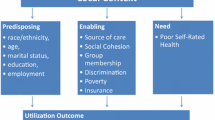Abstract
Public health practice often requires locating individuals in the community. This article presents information on the methods and amount of time and effort required to locate over 2300 low-income and minority women in Maryland, New York, Ohio, and Texas for a mammography rescreening study. In 1999, we identified 2528 low-income women who had a mammogram in 1997 funded by the National Breast and Cervical Cancer Early Detection Program. Starting 30 months after that mammogram, we made numerous attempts to locate each woman while recording the number of calls, letters, and tracing attempts used and the date she was found. More than 93% of the women were located. On average, it took 73.8 days (range 1–492 days) and 7.2 calls and letters (range 1–48) to reach each woman. Locating women in racial and ethnic minority groups required more time and effort. About 10% of all located women were found only after our subject tracing protocol was implemented. The percentage of located women increased markedly with more months of effort and additional calls and letters. Because women who were more difficult to locate were less likely to have been rescreened, the mammography rescreening percentages at the end of the study were slightly lower than they would have been had we terminated location efforts after 1–3 months. Locating low-income women in the community is difficult, particularly when obtaining a high response rate from all groups is important. Terminating data collection prematurely may decrease minority group representation and introduce bias.

Similar content being viewed by others

References
U.S. Preventive Services Task Force (1996). Guide to clinical preventive services, 2nd ed. Baltimore, Williams & Wilkins
Bobo JK, Shapiro JA, Schulman J, Wolters C (2004). On-schedule mammography rescreening in the National Breast and Cervical Cancer Early Detection Program. Cancer Epid Biomarkers Prev 13:620–630
American College of Radiology (1995). Breast imaging reporting and data system (BI-RADS) - 2nd Edition. Reston VA, American College of Radiology
Hartsough C, Babinski L, Lambert NM (1996). Tracking procedures and attrition containment in a long-term follow-up of a community-based ADHD sample. J Child Psychol Psychiat 37:705–713
Russell C, Palmer J, Adams-Campbell L, Rosenberg L (2001). Follow-up of a large cohort of Black women. Am J Epidemiol 154:845–853
Senturia Y, Mortimer K, Baker D, Gergen P, Mitchell H, Jospeh C et al (1998). Successful techniques for retention of study participants in an inner-city population. Control Clin Trials 19:544–554
Folmar S, Oates-Williams F, Sharp P, Reboussin D, Smith J, Cheshire K et al (2004). Recruitment of participants for an estrogen replacement and atherosclerosis (ERA) trial: A comparison of costs, yields, and participant characteristics from community and hospital based recruitment strategies. Control Clin Trials 22:13–25
Zapka JG, Chasan-Taber L, Bigelow C, Hurley T (1994). Methodological issues for health-related surveys of multicultural women. Eval Health Prof 17:485–500
Helasoja V, Prattala R, Dregval L, Purdule I, Kasmel A (2002). Late response and item nonresponse in the Finbalt Health Monitoring Survey. Eur J Public Health 12:117–123
Badawi M, Eaton W, Myllyluoma J, Weimer L, Gallo J (1999). Psychopathology and attrition in the Baltimore ECA 15-year follow-up 1981–1996. Soc Psychiatry Psychiatr Epidemiol 34:91–98
Shahar E, Folsom A, Jackson R (1996). The effect of nonresponse on prevalence estimates for a referent population: Insights from a population-based cohort study. Am J Epidemiol 6:498–506
Kotaniemi J, Hassi J, Kataja M, Jonsson E, Laitinen L, Sovijarvi A et al (2001). Does non-responder bias have a significant effect on the results in a postal questionnaire study?. Eur J Epidemiol 17:809–817
Paganini-Hill A, Hsu G, Chao A, Ross R (1993). Comparison of early and late respondents to a postal health survey questionnaire. Epidemiology 4:375–379
Author information
Authors and Affiliations
Corresponding author
Additional information
Janet Kay Bobo is an Epidemiologist, at Battelle Centers for Public Health Research and Evaluation, Seattle, Washington. Jean A. Shapiro is an Epidemiologist at the Division of Cancer Prevention and Control, National Center for Chronic Disease Prevention and Health Promotion, Centers for Disease Control and Prevention, Atlanta, Georgia. Jennifer Brustrom is a Scientist at Battelle Centers for Public Health Research and Evaluation, Atlanta, GA.
Disclaimer: The U.S. Government does not endorse or favor any specific commercial product or company. Trade, proprietary, or company names appearing in this article are used only because they are considered necessary in the context of the information provided. If a product is not mentioned, the omission does not mean or imply that the product is unsatisfactory.
Rights and permissions
About this article
Cite this article
Bobo, J.K., Shapiro, J.A. & Brustrom, J. Efforts to Locate Low-Income Women for a Study on Mammography Rescreening: Implications for Public Health Practice. J Community Health 31, 249–261 (2006). https://doi.org/10.1007/s10900-005-9006-0
Published:
Issue Date:
DOI: https://doi.org/10.1007/s10900-005-9006-0



